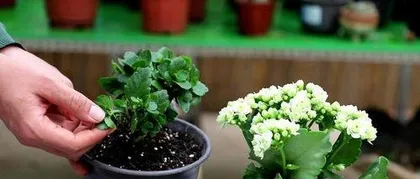Why won't my Kalanchoe blossfeldiana bloom recently? Don't worry, let me give you some tips to make your Kalanchoe bloom like a little sun, so beautiful!
I. Sunlight, sunlight, and more sunlight!
Kalanchoe blossfeldiana is a sun-loving plant; it loves to bask in the sun. It needs at least 4 hours of direct sunlight daily to grow strong and produce beautiful flowers. However, be careful in the summer, as the midday sun can be too strong and scorch the leaves. Remember to provide some shade!
II. Watering, watering, it's all about technique
Although Kalanchoe blossfeldiana is drought-tolerant, it shouldn't be left thirsty. The key to watering is 'let it dry out a bit before soaking it,' which means watering thoroughly only after the top 2-3 cm of soil has dried out. In winter, you can extend this to once a week. Remember, standing water is the enemy of Kalanchoe. If you see water in the saucer, pour it out immediately, or the roots will rot!
III. Soil, soil, good drainage is most important
The roots of Kalanchoe blossfeldiana don't like to be stuffy, so the soil must be well-draining. You can mix your own soil using peat moss, perlite, and vermiculite in a 5:3:2 ratio, or you can buy a specialized succulent soil mix and add some river sand to ensure good aeration and drainage.
IV. Fertilizing, fertilizing, use light fertilizer frequentlyKalanchoe blossfeldiana likes fertilizer, but don't overdo it. During the growing season, apply a balanced, diluted nitrogen-phosphorus-potassium fertilizer every 10 days. When it's time for budding, switch to a high-phosphorus-potassium fertilizer, applying it both as a foliar spray and to the soil. This will encourage so many flower buds that the branches will bend under their weight!
V. Pruning, pruning, for more abundant flowersThe flowers of Kalanchoe blossfeldiana grow at the tips of the branches, so regular pruning is necessary to encourage more lateral branches and thus more flowers. After the flowers have faded, promptly remove the dead blooms and the few leaves below them to concentrate nutrients for new growth.
VI. Propagation, propagation, one plant becomes manyPropagating Kalanchoe blossfeldiana is very simple, with stem cuttings being the most common method. Cut a healthy stem of 5-8 cm, let the cut callous over for a day, then insert it into moist soil. It will root in about 15 days. You can also transplant seedlings, but be sure to place them in a shady spot initially to help them gradually adapt to the light.
VII. Precautions, precautions, don't ignore them1. Temperature: Kalanchoe blossfeldiana prefers a warm environment, with an optimal growing temperature of 15-25°C. In winter, keep it above 10°C to avoid frost damage.
2. Pests and Diseases: Be sure to observe your plant regularly. If you notice any pests or diseases, treat them promptly to prevent them from affecting the plant's growth.
3. Repotting: You can repot your Kalanchoe blossfeldiana once a year, in either spring or autumn. Use fresh soil to help it grow healthier.
VIII. Tips, tips, to make plant care easier1. Egg Water: Separate the egg white from the yolk. Bury the yolk in the soil, and after the egg white has fermented, use it to water your plant. This can make the leaves greener and the flowers more vibrant.
2. Potassium Dihydrogen Phosphate (Monopotassium Phosphate): Spray with potassium dihydrogen phosphate during the budding stage to make the flowers fuller and their colors more brilliant.
3. Pruning Tip: When pruning, be sure to leave the bud points intact, as this will allow the Kalanchoe to grow more lush.
After all that, aren't you eager to get a Kalanchoe blossfeldiana of your own? Give it a try, I promise, your plant will bloom beautifully!